Pebworth-Long Marston-Stratford upon Avon Transfer (2018)
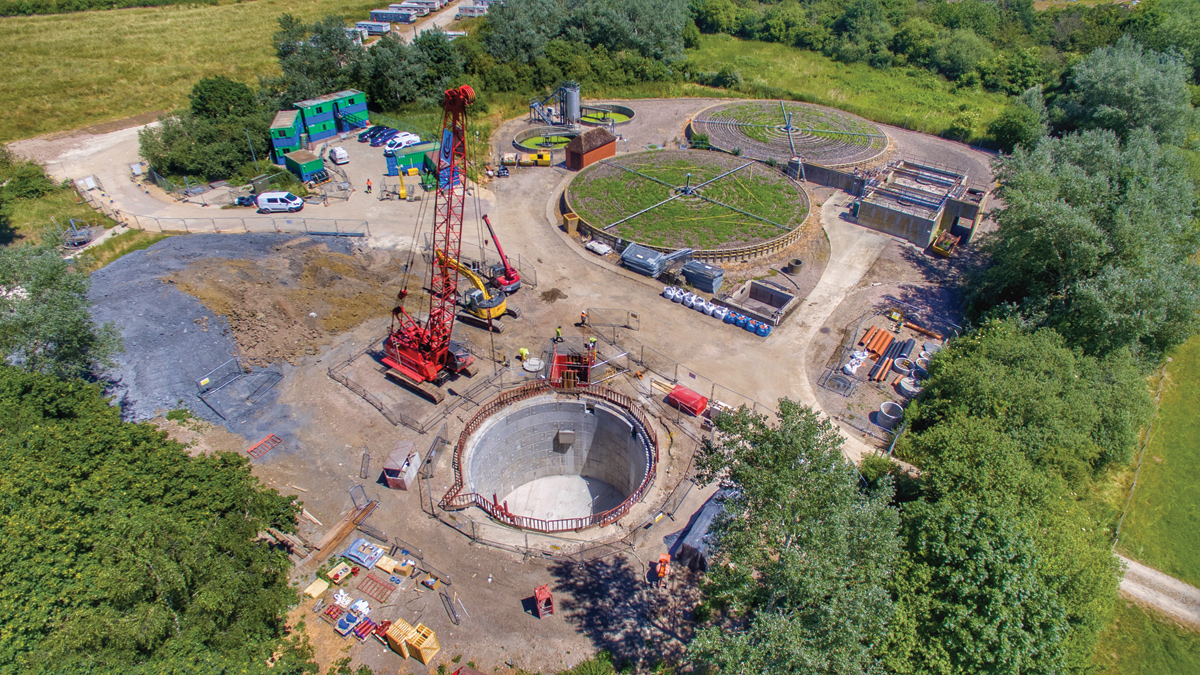
Long Marston STW - Photo by Cadsite Services - Courtesy of NMCNomenca (now Galliford Try)
Long Marston Sewage Treatment Works (STW) is located approximately 4 miles south of Stratford-upon-Avon in Warwickshire and until recently was treating wastewater from a population of 2,500 in Long Marston and Quinton. Significant development in the catchment will see the population served rise to approximately 15,000 over the next 20 years. The former Ministry of Defence Long Marston Depot is already partly developed, now known as Meon Vale, and will eventually consist of around 1,800 properties, whilst the Long Marston Airfield Garden Village will see 3,500 new properties built. With additional wastewater from the initial phases of Meon Vale already increasing the load on the treatment process, the existing STW was forecast to breach its final effluent consent by 2019. In addition, 4km away across the county border in south-east Worcestershire, Pebworth Village STW (built in the 1950s and serving a population of 600), had been assessed as life-expired.
Options and solution

(left) Obsolete inlet pumps at Pebworth STW and (right) PST in poor condition at Pebworth STW – Courtesy of NMCNomenca (now Galliford Try)
A flow transfer solution to Long Marston was assessed by Severn Trent Water as more cost effective than a replacement STW at Pebworth. The solution additionally facilitates the uprating of an existing terminal pumping station and short rising main in order to reduce sewer flooding risk in the hamlet of Broad Marston.

(left) Route of Pebworth rising main on approach to Long Marston STW and (right) route of Pebworth rising main on approach to Long Marston STW – Photo by Cadsite Services – Courtesy of NMCNomenca
At Long Marston a number of options were considered including a partial transfer option as well as a complete rebuild of the STW, however, a full-flow transfer solution to Milcote STW (5.5km away in Stratford), was assessed as offering the best value TOTEX solution, in part due to an opportunity to recommission a moth-balled activated sludge plant unit at the Milcote site.
In order to gain Environment Agency endorsement of the proposal, hydraulic modelling was used in order to demonstrate no deterioration in overall sewer storm overflow spills across Pebworth, Long Marston and Milcote combined. This resulted in a design incorporating 900m3 of storage at the Long Marston Transfer Pumping Station along with a pass forward flow of 67l/s. To ensure this storage volume is fully utilised, a telemetry link between the site and Milcote is required so that the Long Marston Sewage Pumping Station (SPS) will be inhibited when, and for as long as, spill is occurring into the storm tanks at Milcote STW (unless top water level is reached at Long Marston SPS at which point the inhibit will be released). At Pebworth it was required to pass forward 15.2l/s and incorporate 115m3 of storage within the wet well prior to storm spill.
Pebworth transfer
A new 5m diameter, 9m deep SPS was constructed within the grounds of the existing treatment works. There was only a small area of land at the entrance to the site that looked suitable for siting the SPS, so trial holes were dug to confirm previous use of the land and a borehole sunk to confirm ground conditions. The new Pebworth SPS wet well was constructed by Active Tunnelling Ltd using a caisson technique with rings and a cutting shoe under jacking pressure. Once at formation level, the concrete plug was constructed to prevent flotation. The shaft was then grouted, benched and the cover slab fitted (also providing anti-flotation).
The internal pipework was then fitted out utilising an access scaffold with a number of decks to provide access to fixing beams and flanges. Finally connecting to an above-ground valve arrangement before connecting on to the new rising main. A new motor control center and kiosk with a new telemetry outstation and flow monitoring equipment has been installed at the site and located above the 1 in 100 year flood level of the adjacent brook. The equipment is now all ready to connect on to once Long Marston SPS has been completed and commissioned, along with a new 2,500L dosing unit installed to prevent septicity in the new main. Once commissioned, the existing STW will be decommissioned and moth-balled.
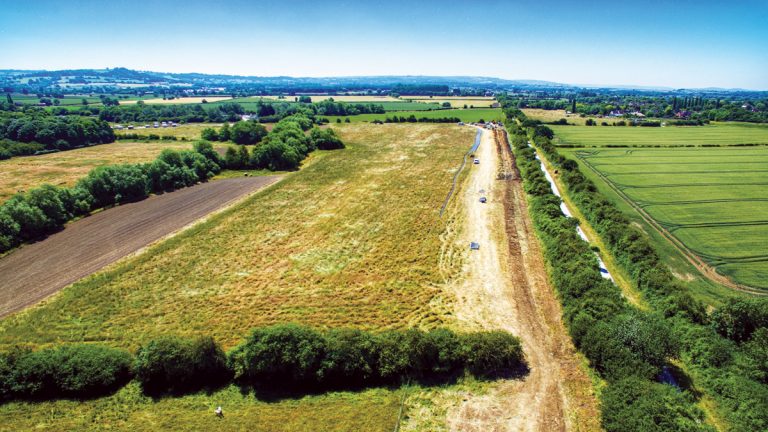
Section of Long Marston Rising Main – Photo by Cadsite Services – Courtesy of NMCNomenca
A new rising main was constructed to convey the flows from the Pebworth SPS to the Long Marston catchment. During the detailed design of the rising main it was found that the rising main high point was approximately half way along the route of the pipe and the remainder of the main had an undulating profile with the discharge the lowest point. This would have resulted in varying larger sizes of main for the ‘falling’ sections of pipework, varying in size between 200mm and 350mm diameter to maintain stable flows in the main and prevent air locking. To overcome this, it was agreed to utilise the existing raised inlet at Long Marston works for the new incoming rising main, which meant that the new main would be fully primed and was sized at 180mm outside diameter, PE100 SDR 11 for the full 3.92km length.
The new rising main route crossed many arable fields along with fields with ridge and furrow. The clay ground meant ideal conditions for directionally drilling the new main which helped with stakeholder consultations including landowners and county archaeologists due to the minimal ground disturbance when compared to open cut. The main was drilled with drilling pits spaced at 100m to 200m intervals. The rising main pipe sections were delivered in coils and a combination of mechanical couplers and electrofusion welds were used to connect the sections together.
Along the route of the new rising main there were three national high pressure Cadent gas mains, which resulted in six separate crossings of these gas mains with the new rising main, of which two crossings were in the highway and the other four within fields. Various site visits were undertaken with Cadent plant protection engineers to locate the mains, plan the route, agree trial trenches and construction methods and determine the requirements for crossing the gas mains with construction plant, i.e. temporary rafts and fencing. The plant protection engineers were present when the new rising main was constructed around the gas pipes to monitor the construction work and to provide advice and guidance where necessary.
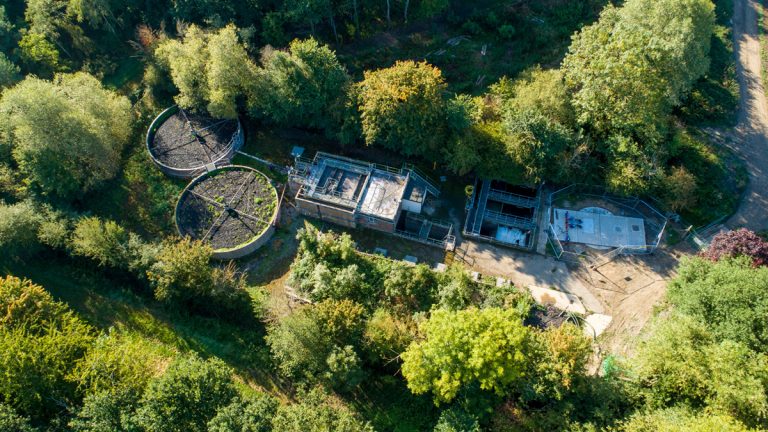
New SPS under construction at entrance to Pebworth STW: Photo by Cadsite Services – Courtesy of NMCNomenca
Long Marston transfer
A new 12.5m diameter, 12m deep sewage pumping station was constructed within the grounds of the current Long Marston STW. The size of the STW is significantly larger than Pebworth and there was an area of land to the south-west of the works that used to make up the former settlement tanks before they were abandoned and buried. Using historical plans of the formers works, along with topographical and radar surveys, an area for the footprint of the new SPS was determined and a programme of site investigation including trial holes, boreholes, California bearing ratio (CBR) and contamination testing undertaken.
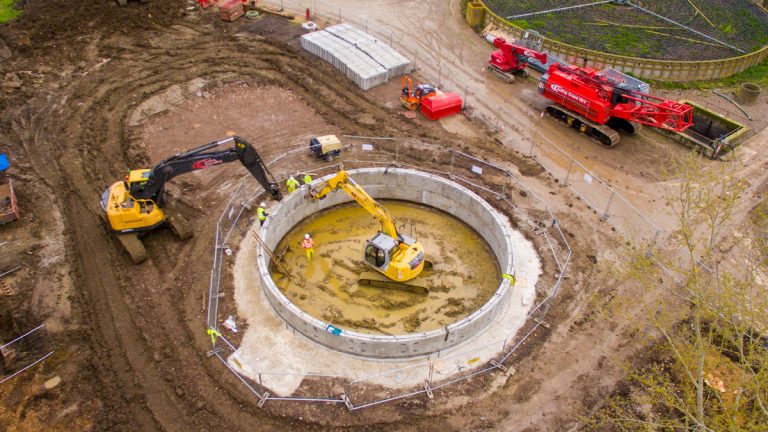
Long Marston shaft under construction – Photo by Cadsite Services – Courtesy of NMCNomenca
The new pumping station will pump flows through a new 315mm (outside diameter) 5.45km long rising main to Stratford Milcote STW. The route of the new rising main runs along the edge of field boundaries parallel to the Stratford Greenway, which is a disused railway path, now a trail for walkers and cyclists, linking Long Marston with Stratford.
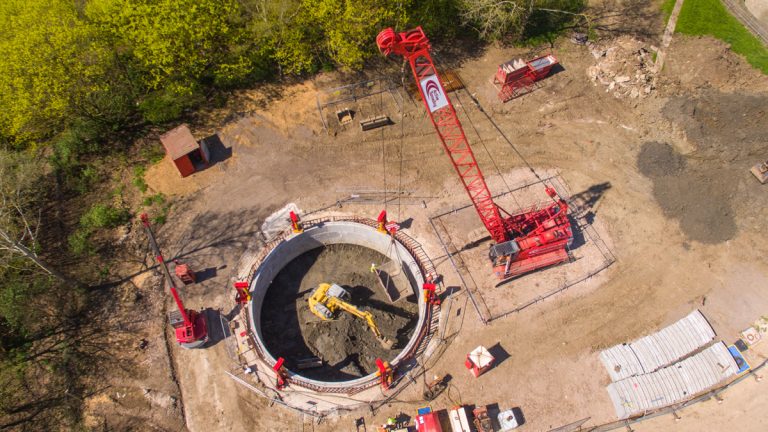
Long Marston shaft under construction – Photo by Cadsite Services – Courtesy of NMCNomenca
The ground condition at the southern end of the route is clay, changing to sands and gravels at the northern end towards the River Avon and Milcote STW. Due to the linear nature of the route, it was preferred to lay the new rising main using a trenching machine with directional drilling utilised for watercourse crossings.
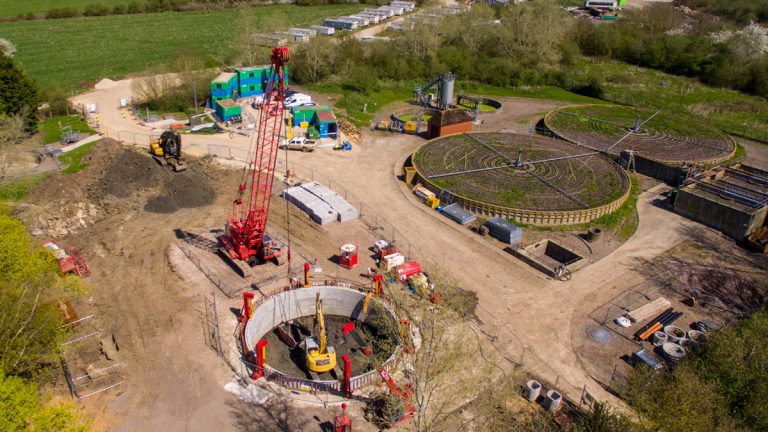
Long Marston shaft under construction – Photo by Cadsite Services – Courtesy of NMCNomenca
However, cropmarks shown on aerial photographs identified potential archaeological features in the area of sands and gravels and the county archaeologist had concerns that the trenching machine may destroy other archaeological features along the entire route. A programme of archaeological work involving extensive trial trenching was carried out and a Written Scheme of Investigation for the pipe laying agreed including the use of machine dug trenches instead of a trenching machine along with a watching brief for top and subsoil stripping. At the time of writing this report (July 2018), various roman settlements and a burnt mound had been discovered along the route of the main.
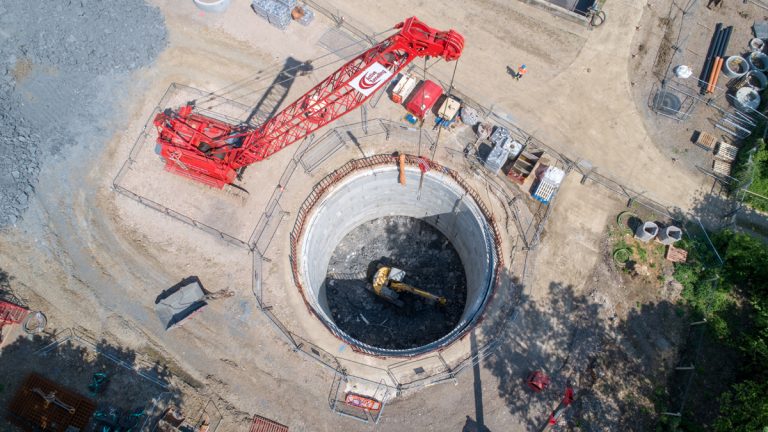
Long Marston shaft under construction – Photo by Cadsite Services – Courtesy of NMCNomenca
Construction of the new SPS at Long Marston is ongoing with the shaft now in complete, fully fitted out and cover slab on. Following delays in starting the rising main due to the archaeology constraints, completion is now expected in October 2018.




